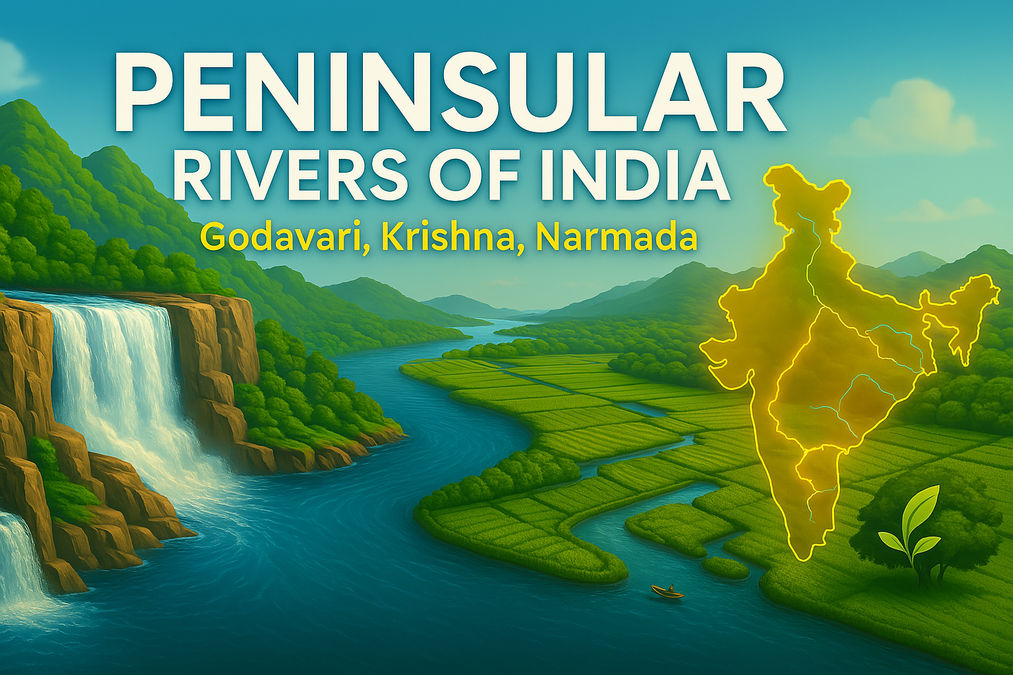Peninsular Rivers of India: Godavari, Krishna, Narmada, and More

Peninsular Rivers of India: Godavari, Krishna, Narmada, and More
The Peninsular rivers of India, such as Godavari, Krishna, and Narmada, are vital to the southern and central regions, supporting agriculture and hydropower. Unlike the perennial Himalayan rivers, these are mostly seasonal, relying on rainfall. This guide explores their features, basins, and economic roles.
Did You Know? The Godavari, known as Dakshin Ganga, is the largest Peninsular river with a 1,500 km course.
Overview of Peninsular Rivers
Peninsular rivers, originating in the Western Ghats or central highlands, are seasonal and have shorter, shallower courses compared to Himalayan rivers. Most flow east into the Bay of Bengal, forming deltas, while Narmada and Tapi flow west, creating estuaries.
The Godavari River System
The Godavari, the largest Peninsular river, rises in the Western Ghats in Maharashtra. Spanning 1,500 km, its basin covers Maharashtra, Madhya Pradesh, Odisha, and Andhra Pradesh. Major tributaries include Purna, Wardha, and Pranhita.
Conservation Note: The Godavari supports extensive irrigation, making it a key agricultural resource in South India.
The Narmada and Tapi Rivers
The Narmada rises in Amarkantak, Madhya Pradesh, and flows west through a rift valley, creating scenic spots like the Marble Rocks and Dhuadhar Falls. The Tapi, originating in the Satpura ranges, is shorter and also flows through a rift valley.
The Krishna and Kaveri Rivers
The Krishna, stretching 1,400 km, and the Kaveri, at 760 km, originate in the Western Ghats and flow into the Bay of Bengal. The Kaveri forms the Shivasamudram Falls, India's second-largest waterfall, used for hydropower.
Timeline: Journey of Peninsular Rivers
Origin
Most originate in the Western Ghats or central highlands, like Amarkantak and Satpura.
Course
Shorter and shallower compared to Himalayan rivers, with seasonal flow dependent on rainfall.
Lower Course
East-flowing rivers form deltas; west-flowing Narmada and Tapi create estuaries.
Economic Impact
Support irrigation, hydropower, and agriculture in Peninsular India.
Comparison of Peninsular Rivers
| River | Length (km) | Origin | Major Tributaries |
|---|---|---|---|
| Godavari | 1,500 | Western Ghats, Maharashtra | Purna, Wardha, Pranhita |
| Narmada | 1,312 | Amarkantak, Madhya Pradesh | Short tributaries |
| Tapi | 724 | Satpura, Madhya Pradesh | Short tributaries |
| Krishna | 1,400 | Western Ghats, Maharashtra | Tungabhadra, Koyana, Bhima |
| Kaveri | 760 | Brahmagiri, Western Ghats | Amravati, Bhavani, Hemavati |
Economic Importance
Peninsular rivers are critical for irrigation, hydropower, and agriculture. The Kaveri powers cities like Mysuru and Bengaluru, while the Godavari supports vast farmlands. Conservation efforts like Namami Devi Narmade aim to protect these vital resources.
Fun Fact: The Kaveri’s Shivasamudram Falls generates hydroelectric power for the Kolar Gold Fields.
FAQs
What are the major Peninsular rivers in India?
The major Peninsular rivers include Godavari, Krishna, Kaveri, Narmada, and Tapi.
Which is the largest Peninsular river in India?
The Godavari is the largest Peninsular river, also known as Dakshin Ganga.
Where does the Narmada River originate?
The Narmada originates in the Amarkantak hills in Madhya Pradesh.
What is the largest river basin in India?
The Ganga River has the largest river basin in India, but among Peninsular rivers, Godavari has the largest basin.
Which Peninsular rivers flow through a rift valley?
The Narmada and Tapi rivers flow through rift valleys.
What are the tributaries of the Godavari?
Major tributaries of the Godavari include Purna, Wardha, Pranhita, Manjra, Wainganga, and Penganga.
What is the Namami Devi Narmade scheme?
It is a conservation mission by the Madhya Pradesh government to protect the Narmada River.
Which river forms the Shivasamudram Falls?
The Kaveri River forms the Shivasamudram Falls, the second largest waterfall in India.
Why are Peninsular rivers seasonal?
Peninsular rivers depend on rainfall, leading to reduced flow during the dry season.
What are the economic benefits of Peninsular rivers?
They support irrigation, hydropower, and agriculture, contributing significantly to the economy.
Conclusion
The Peninsular rivers, with their seasonal flows and vital deltas, are essential to India’s southern and central regions. Their role in agriculture, hydropower, and conservation efforts highlights their importance. Dive deeper into these rivers to understand their impact on India’s growth.
Explore More About India's Geography
Join the conversation